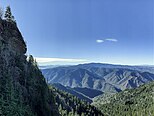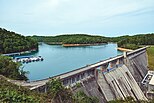
A | B | C | D | E | F | G | H | CH | I | J | K | L | M | N | O | P | Q | R | S | T | U | V | W | X | Y | Z | 0 | 1 | 2 | 3 | 4 | 5 | 6 | 7 | 8 | 9
East Tennessee | |
|---|---|
|
From top (left to right): Clingmans Dome in Great Smoky Mountains National Park, Neyland Stadium at the University of Tennessee, skyline of Knoxville, skyline of Chattanooga, Norris Dam and its reservoir, Oak Ridge National Laboratory, Sycamore Shoals State Historic Area | |
| Nickname(s): East TN, East Tenn. | |
 The counties of East Tennessee highlighted in red | |
| Country | |
| State | |
| Largest city | Knoxville |
| Area | |
| • Land | 35,115.8 km2 (13,558.27 sq mi) |
| Population (2020) | 2,470,105 |
| • Density | 70.34/km2 (182.18/sq mi) |
| Demonym | East Tennessean |
East Tennessee is one of the three Grand Divisions of Tennessee defined in state law. Geographically and socioculturally distinct, it comprises approximately the eastern third of the U.S. state of Tennessee. East Tennessee consists of 33 counties, 30 located within the Eastern Time Zone and three counties in the Central Time Zone, namely Bledsoe, Cumberland, and Marion.[1] East Tennessee is entirely located within the Appalachian Mountains, although the landforms range from densely forested 6,000-foot (1,800 m) mountains to broad river valleys. The region contains the major cities of Knoxville and Chattanooga, Tennessee's third and fourth largest cities, respectively, and the Tri-Cities, the state's sixth largest population center.
During the American Civil War, many East Tennesseans remained loyal to the Union even as the state seceded and joined the Confederacy. Early in the war, Unionist delegates unsuccessfully attempted to split East Tennessee into a separate state that would remain as part of the Union. After the war, a number of industrial operations were established in cities in the region. The Tennessee Valley Authority (TVA), created by Congress during the Great Depression in the 1930s, spurred economic development and helped to modernize the region's economy and society. The TVA would become the nation's largest public utility provider. Today, the TVA's administrative operations are headquartered in Knoxville, and its power operations are based in Chattanooga. Oak Ridge was the site of the world's first successful uranium enrichment operations, which were used to construct the world's first atomic bombs, two of which were dropped on Imperial Japan at the end of World War II.[2] The Appalachian Regional Commission further transformed the region in the late 20th century.
East Tennessee is both geographically and culturally part of Appalachia.[3] East Tennessee is home to the nation's most visited national park—the Great Smoky Mountains National Park—and hundreds of smaller recreational areas. East Tennessee is often considered the birthplace of country music, stemming from the 1927 Victor recording sessions in Bristol, and throughout the 20th and 21st centuries has produced a steady stream of musicians of national and international fame.[4]
Geography


Unlike the geographic designations of regions of most U.S. states, the term East Tennessee has legal as well as socioeconomic and cultural meaning. Along with Middle Tennessee and West Tennessee, it comprises one of the state's three Grand Divisions, whose boundaries are defined by state law. With a total land area of 13,558.27 square miles (35,115.8 km2), comprises 32.90% of the state's land area and is the second-largest of the Grand Divisions, behind Middle Tennessee.[5] The entirety of East Tennessee is both geographically and culturally part of Appalachia and the Appalachian Mountains and is usually considered part of the Upland South.[6] East Tennessee borders North Carolina to the east, Virginia to the northeast, Kentucky to the north, Georgia to the south, and Alabama in the extreme southwest corner.
According to custom, the boundary between East and Middle Tennessee roughly follows the dividing line between Eastern and Central Time Zone. Exceptions to this rule are that Bledsoe, Cumberland, and Marion Counties are legally defined as part of East Tennessee, despite being within the Central Time Zone. Sequatchie County, located between Marion and Bledsoe Counties, is legally part of Middle Tennessee but is often considered part of East Tennessee. Sequatchie County has also been defined as part of East Tennessee in the past, and Marion County has been included in Middle Tennessee. Some of the northeastern counties of Middle Tennessee that supported the Union during the American Civil War, including Fentress and Pickett, are sometimes culturally considered part of East Tennessee. Fentress County in particular has been widely viewed by many as East Tennessee because it is located on the western edge of the Knoxville television market as opposed to Pickett County which is in the northeastern tip of Nashville television market.
Topography

East Tennessee is located within three major geological divisions of the Appalachian Mountains: the Blue Ridge Mountains on the border with North Carolina in the east; the Ridge-and-Valley Appalachians (usually called the "Great Appalachian Valley" or "Tennessee Valley"[a]) in the center; and the Cumberland Plateau in the west, part of which is in Middle Tennessee. The southern tip of the Cumberland Mountains also extends into the region between the Cumberland Plateau and Ridge-and-Valley regions. Both the Cumberland Plateau and Cumberland Mountains are part of the larger Appalachian Plateau.[7]
The Blue Ridge section comprises the western section of the Blue Ridge Province, the crests of which form most of the Tennessee-North Carolina border. At an average elevation of 5,000 feet (1,500 m) above sea level, this physiographic province contains the highest elevations in the state.[8] The Blue Ridge region is subdivided into several subranges—the Iron Mountains, Unaka Range,[b] and Bald Mountains in the north; the Great Smoky Mountains in the center; and the Unicoi Mountains, Little Frog Mountain, and Big Frog Mountain areas in the south.[9] Clingmans Dome, at 6,643 feet (2,025 m), is the state's highest point and is located in the Great Smoky Mountains along the Tennessee-North Carolina border.[8] Most of the Blue Ridge section is heavily forested and protected by various state and federal entities, the largest of which include the Great Smoky Mountains National Park and the Cherokee National Forest.[10] The Appalachian Trail enters Tennessee in the Great Smoky Mountains and roughly follows the border with North Carolina most of the distance to near the Roan Mountain, where it shifts entirely into Tennessee.[11]
The Ridge-and-Valley division is East Tennessee's largest, lowest lying, and most populous section. It consists of a series of alternating and paralleling elongate ridges with broad river valleys in between, roughly oriented northeast-to-southwest. This section's most notable feature, the Tennessee River, forms at the confluence of the Holston and French Broad rivers in Knoxville and flows southwestward to Chattanooga. The lowest point in East Tennessee, at an elevation of approximately 600 feet (180 m), is found where the Tennessee River enters Alabama in Marion County.[12] Other notable rivers in the upper Tennessee watershed include the Clinch, Nolichucky, Watauga, Emory, Little Tennessee, Hiwassee, Sequatchie, and Ocoee rivers. Notable "ridges" in the Ridge-and-Valley range, which exceed elevations much greater than most surrounding ridges and are commonly referred to as mountains, include Clinch Mountain, Bays Mountain, and Powell Mountain.[8]
The Cumberland Plateau rises nearly 1,000 feet (300 m) above the Appalachian Valley, stretching from the Kentucky border in the north to the Georgia and Alabama borders in the south.[8] It has an average elevation of 2,000 feet (610 m) and consists mostly of flat-topped tablelands, although the northern section is slightly more rugged.[7][13] The plateau has many waterfalls and stream valleys separated by steep gorges.[14] The "Tennessee Divide" runs along the western part of the plateau, separating the watersheds of the Tennessee and Cumberland rivers. Plateau counties mostly east of this divide—i.e. Cumberland, Morgan, and Scott—are grouped with East Tennessee, whereas plateau counties west of this divide, such as Fentress, Van Buren, and Grundy, are considered part of Middle Tennessee. Most of the Sequatchie Valley, a long narrow valley in the southeastern part of the Cumberland Plateau, is in East Tennessee.[c] The part of the plateau east of the Sequatchie Valley is called Walden Ridge. One notable detached section of the plateau is Lookout Mountain, which overlooks Chattanooga.[16] West of Chattanooga, the Tennessee River flows through the plateau in the Tennessee River Gorge.
The Cumberland Mountains begin directly north of the Sequatchie Valley and extend northward to the Cumberland Gap at the Tennessee-Kentucky-Virginia tripoint. While technically a separate physiographic region, the Cumberland Mountains are usually considered part of the Cumberland Plateau in Tennessee. The Cumberland Mountains reach elevations above 3,500 feet (1,100 m) in Tennessee, and their largest subrange is the Crab Orchard Mountains. The Cumberland Trail traverses the eastern escarpment of the Cumberland Plateau and Cumberland Mountains.[17]
Counties
The Official Tourism Website of Tennessee has a definition of East Tennessee slightly different from the legal definition; the website excludes Cumberland County while including Grundy and Sequatchie Counties.[18]
Climate
| Climate data for Chattanooga Metropolitan Airport, Tennessee (1991–2020 normals,[d] extremes 1879–present[e]) | |||||||||||||
|---|---|---|---|---|---|---|---|---|---|---|---|---|---|
| Month | Jan | Feb | Mar | Apr | May | Jun | Jul | Aug | Sep | Oct | Nov | Dec | Year |
| Record high °F (°C) | 78 (26) |
82 (28) |
89 (32) |
93 (34) |
99 (37) |
107 (42) |
107 (42) |
105 (41) |
104 (40) |
100 (38) |
86 (30) |
78 (26) |
107 (42) |
| Mean maximum °F (°C) | 68.8 (20.4) |
73.0 (22.8) |
80.6 (27.0) |
86.0 (30.0) |
90.5 (32.5) |
95.2 (35.1) |
97.1 (36.2) |
96.4 (35.8) |
93.5 (34.2) |
85.8 (29.9) |
76.8 (24.9) |
69.3 (20.7) |
98.3 (36.8) |
| Mean daily maximum °F (°C) | 51.0 (10.6) |
55.6 (13.1) |
64.1 (17.8) |
73.6 (23.1) |
81.0 (27.2) |
87.6 (30.9) |
90.5 (32.5) |
89.8 (32.1) |
84.3 (29.1) |
74.1 (23.4) |
62.0 (16.7) |
53.2 (11.8) |
72.2 (22.3) |
| Daily mean °F (°C) | 41.7 (5.4) |
45.6 (7.6) |
53.2 (11.8) |
61.7 (16.5) |
70.0 (21.1) |
77.4 (25.2) |
80.7 (27.1) |
80.0 (26.7) |
73.9 (23.3) |
62.7 (17.1) |
51.2 (10.7) |
44.3 (6.8) |
61.9 (16.6) |
| Mean daily minimum °F (°C) | 32.4 (0.2) |
35.6 (2.0) |
42.2 (5.7) |
49.9 (9.9) |
59.0 (15.0) |
67.3 (19.6) |
71.0 (21.7) |
70.2 (21.2) |
63.6 (17.6) |
51.4 (10.8) |
40.3 (4.6) |
35.3 (1.8) |
51.5 (10.8) |
| Mean minimum °F (°C) | 14.9 (−9.5) |
19.6 (−6.9) |
25.5 (−3.6) |
34.3 (1.3) |
44.1 (6.7) |
56.9 (13.8) |
63.4 (17.4) |
61.9 (16.6) |
50.3 (10.2) |
35.1 (1.7) |
25.9 (−3.4) |
20.8 (−6.2) |
12.9 (−10.6) |
| Record low °F (°C) | −10 (−23) |
−10 (−23) |
2 (−17) |
25 (−4) |
34 (1) |
39 (4) |
51 (11) |
50 (10) |
36 (2) |
22 (−6) |
4 (−16) |
−2 (−19) |
−10 (−23) |
| Average precipitation inches (mm) | 5.02 (128) |
5.03 (128) |
5.34 (136) |
4.87 (124) |
3.94 (100) |
4.18 (106) |
5.08 (129) |
3.67 (93) |
4.23 (107) |
3.59 (91) |
4.80 (122) |
5.25 (133) |
55.00 (1,397) |
| Average snowfall inches (cm) | 1.0 (2.5) |
1.2 (3.0) |
1.1 (2.8) |
0.0 (0.0) |
0.0 (0.0) |
0.0 (0.0) |
0.0 (0.0) |
0.0 (0.0) |
0.0 (0.0) |
0.0 (0.0) |
0.0 (0.0) |
0.3 (0.76) |
3.6 (9.1) |
| Average precipitation days (≥ 0.01 in) | 10.6 | 11.1 | 11.4 | 10.1 | 10.6 | 11.4 | 11.9 | 9.4 | 7.9 | 7.9 | 9.1 | 11.3 | 122.7 |
| Average snowy days (≥ 0.1 in) | 0.7 | 1.1 | 0.3 | 0.0 | 0.0 | 0.0 | 0.0 | 0.0 | 0.0 | 0.0 | 0.0 | 0.3 | 2.4 |
| Average relative humidity (%) | 71.2 | 68.2 | 65.9 | 63.8 | 71.5 | 73.1 | 74.9 | 76.0 | 77.0 | 74.6 | 73.5 | 72.9 | 71.9 |
| Mean monthly sunshine hours | 147.0 | 155.6 | 200.5 | 240.2 | 275.6 | 275.5 | 265.2 | 256.8 | 227.9 | 218.8 | 158.7 | 140.4 | 2,562.2 |
| Percent possible sunshine | 47 | 51 | 54 | 61 | 64 | 63 | 60 | 62 | 61 | 63 | 51 | 46 | 58 |
| Source: NOAA (relative humidity and sun 1961–1990)[20][21][22] | |||||||||||||







